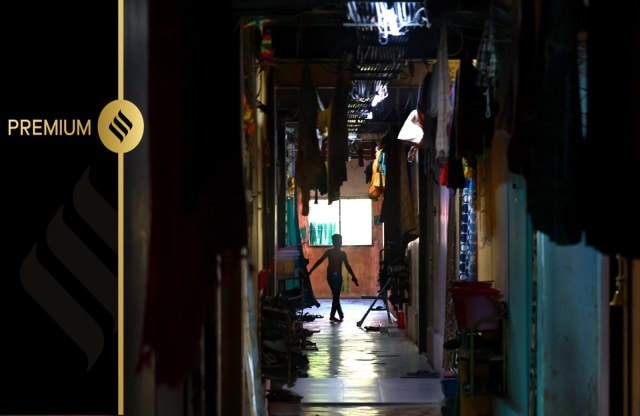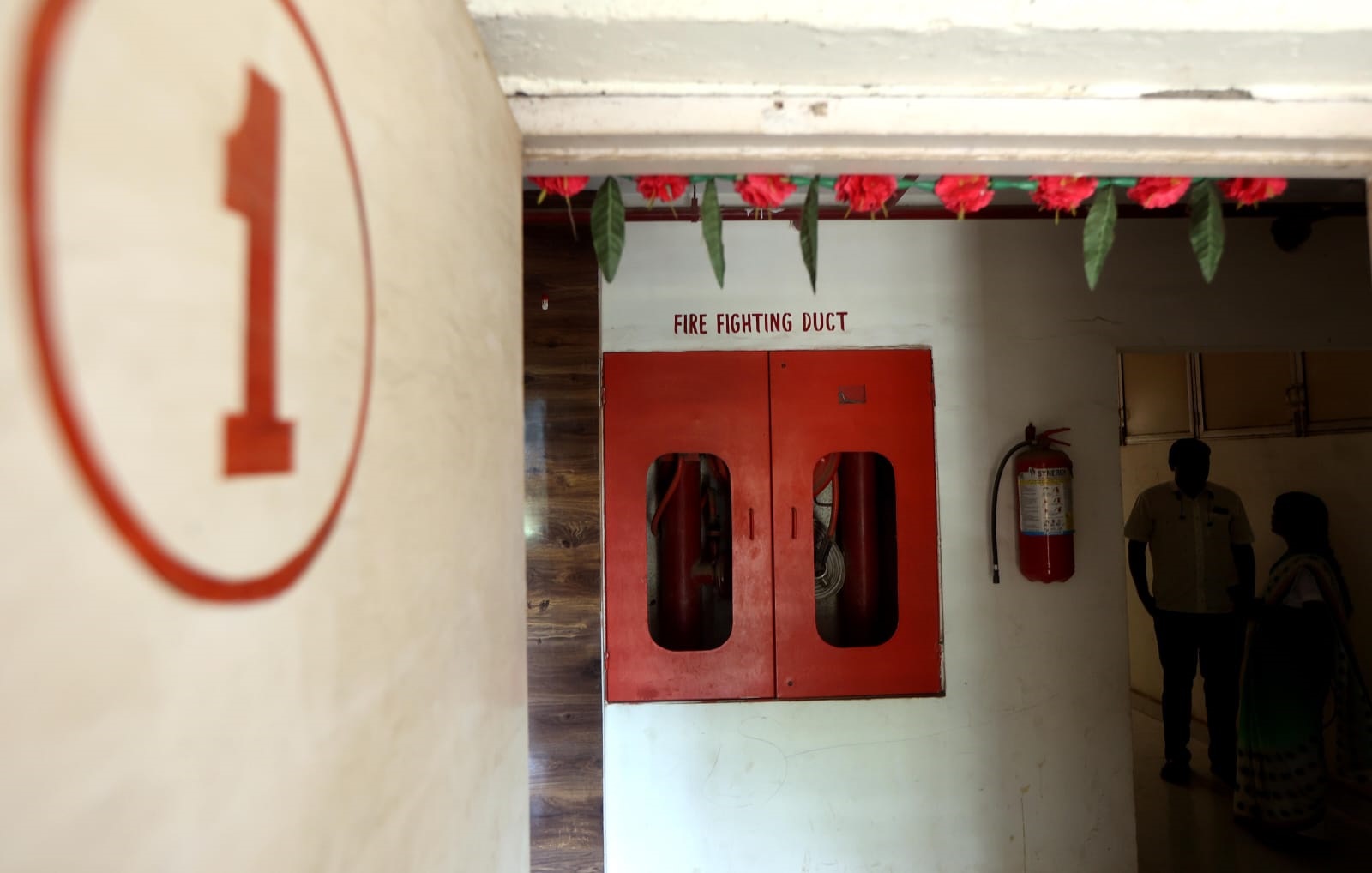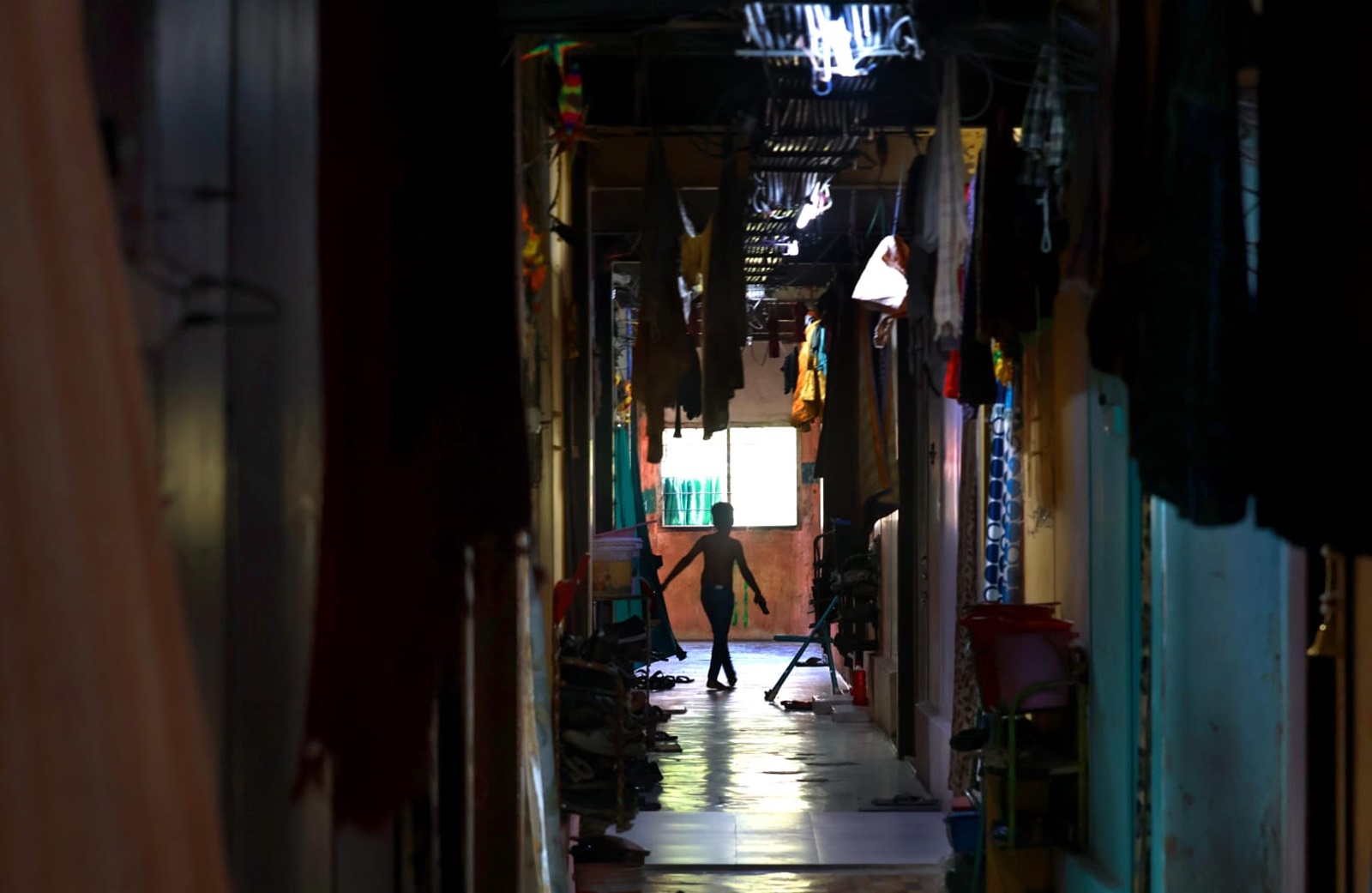Are Mumbai’s slum rehab buildings potential tinderboxes?
Envisaged as the solution to make Mumbai “slum free”, rehab houses and transit camps for slum residents are cutting corners when it comes to fire safety
 An idea mooted by the Maharashtra government, SRA was envisaged as the solution to make Mumbai “slum free”. Since its 1996 launch, SRA has managed to house 2.50 lakh slum dwellers — even though slum households account for 48.35% of the city’s population. (Express photo by Amit Chakravarty)
An idea mooted by the Maharashtra government, SRA was envisaged as the solution to make Mumbai “slum free”. Since its 1996 launch, SRA has managed to house 2.50 lakh slum dwellers — even though slum households account for 48.35% of the city’s population. (Express photo by Amit Chakravarty) In the early hours of October 6, a fire at Goregaon’s Jay Bhavani Slum Rehabilitation Authority (SRA) building claimed eight lives.
While Ravindra Ambulgekar, the Chief Fire Officer of Mumbai Fire Brigade, said the fire had been triggered in the stilt area due to careless disposal of smoking materials like beedi and later fanned by scrap clothes stored within, a site visit by The Indian Express revealed the building had no inbuilt firefighting system. Besides, the building’s location in a narrow lane forced fire personnel to douse the blaze from a distance.
An idea mooted by the Maharashtra government, SRA was envisaged as the solution to make Mumbai “slum free”. Since its 1996 launch, SRA has managed to house 2.50 lakh slum dwellers — even though slum households account for 48.35% of the city’s population. A Geographic Information System (GIS) survey conducted by SRA across Mumbai identified 16 lakh slum settlements spanning 8,333.53 acres.
 Graphic: Abhishek Mitra
Graphic: Abhishek Mitra
Ambulgekar told The Indian Express, “SRA and the fire brigade inspected 425 buildings after the Goregaon incident. Notices to comply with fire safety standards were served to 114 buildings or face electricity and water disconnection. Depending on a building’s condition, the deadline to comply with a notice can be anywhere from 120 days to an hour.”
Building bylaws under the Brihanmumbai Municipal Corporation’s (BMC) Development Control & Promotion Regulation 2034 (DCPR 2034) mandate that each building must have active (fire alarms, sprinklers, wet riser systems, fire hydrants, first aid hose reel, etc.) and passive (a fire escape, horizontal or vertical exits, lift lobby ventilation, fire lift, ramp, refuge area, etc.) firefighting systems.
However, site visits by The Indian Express to SRA buildings revealed the lack of inbuilt firefighting systems and regular fire audits. Coupled with matchbox-style constructions stuffed inside confined lanes, these make the city’s SRA buildings sitting tinderboxes packed with the very people they promised to rehabilitate.
Where the writing is on the wall…
Pointing to the wall-mounted fire extinguisher in Kandivali’s Shakti SRA, a beaming Nikita said, “Corona ke pehle lagaya tha yeh (It was installed before Corona).”
Though the small label on its red body states it “expired in 2021”, the fire extinguisher remains the seven-storey building’s sole protection against a blaze. Since most SRA residents belong to marginalised communities and often lack formal education, they remain unaware of what a functional firefighting system entails. According to senior MFB officials, old SRA buildings are the worst offenders since bylaws did not make it compulsory for them to set up firefighting equipment.
A senior Mumbai Fire Brigade (MFB) official added, “The DCPR 2034 has laid down exhaustive rules on fire safety. It starts with two classifications under the DCPR or National Building Code (NBC) — one, whether the building is residential or commercial or institutional or industrial, etc., and the second, on whether it is a low or a high rise (over 32 metres). There are separate rules for buildings beyond and under 70 metres.”
 Though newer SRA fare slightly better than their aged counterparts, the lack of maintenance and regular fire audits are becoming an issue. (Express photo by Amit Chakravarty)
Though newer SRA fare slightly better than their aged counterparts, the lack of maintenance and regular fire audits are becoming an issue. (Express photo by Amit Chakravarty)
Seeking to address this, the rulebook now mandates the architect/builder to obtain a compliance certificate from the fire brigade, which involves a site inspection. The BMC issues an occupancy certificate (OC) only after approval from the fire department.
Despite their buildings lacking both fire compliance certificates and OCs, several SRAs are already packed with residents.
Rakesh Narayan Gurav, 31, a resident of Omkar Darshan Gundavali SRA CHS Ltd in Andheri East, told The Indian Express, “The builder threatened us saying that our relocation allowance (given by the state to former slum dwellers) would be stopped if we did not take possession immediately. We had little choice but to move into the building in 2022.”
Though newer SRA fare slightly better than their aged counterparts, the lack of maintenance and regular fire audits are becoming an issue.
Activist Bilal Khan of Ghar Bachao Ghar Banao Andolan explained, “Maintenance of SRA buildings, including lifts and getting fire audits, lie with the residents. Most of them are too poor to afford these expenses. Already, the shift from slums to buildings comes with an increase in the cost of living.”
At Vishwadeep SRA, built in 2016 to house the residents of Kandivali’s Babrekar Nagar slums, everything seems perfect at first glance. The entrance has a shiny red box with a wet riser, the hallways have closed electrical ducts, each floor has sprinklers, an extinguisher and a ‘fire board’ with instructions in case of a blaze, and the building’s wide corridors are free of obstruction. However, residents fear these firefighting systems would prove useless due to lack of regular audits.
 Lack of funds prevents many SRA societies from getting the audits routinely. (Express photo by Amit Chakravarty)
Lack of funds prevents many SRA societies from getting the audits routinely. (Express photo by Amit Chakravarty)
Sudhakar Sadawarte, 65, the president of the Kandivali SRA building, alleged the builder had not carried out fire audits citing monetary constraints.
He added, “We took possession of the building in 2016. Several residents fail to pay their monthly maintenance on time, which makes it difficult for me to do my job properly.”
While the MFB is not authorised to conduct fire safety audits, guidelines require societies to get their structures checked by state-approved licensed private agencies regularly. However, lack of funds prevents many SRA societies from getting these audits routinely.
At Govandi’s Jay Hanuman SRA Society, the red box that should ideally contain a wet riser has been reduced to a dustbin. Pointing to the exposed mangle of black cables, which run from the meter room to individual flats, that end just a foot over his head, a resident said, “I feel like I live inside a death trap.”
SRA Chief Executive Officer (CEO) Satish Lokhande told The Indian Express that the one-time maintenance deposit paid by developers for each tenement is slated to be increased to ensure proper maintenance of rehab buildings. The maximum amount, depending on a building’s height, could reach Rs 1 lakh per tenement, he added.
Blocked and loaded
Space — both inside and outside SRAs — is another major issue when it comes to fire safety. Approach roads to most SRA buildings in the city are so narrow that even the smallest of hatchbacks cannot enter the street, forget fire engines.
Recalling the fire brigade’s struggle to douse the October 6 fire, an onlooker said, “The fire engines could not enter the narrow lanes.”
Urban architect Vivek Pai told The Indian Express, “Most SRA buildings violate the NBC 2016 (which lays down rules for authorities and construction firms). The poor design makes it impossible for fire engines to enter the narrow lanes. There is no light and ventilation (in the buildings) due to the matchbox-like construction. Most buildings don’t have a firefighting system or a fire escape either.”
 Site visits by The Indian Express to SRA buildings revealed the lack of inbuilt firefighting systems and regular fire audits. (Express photo by Amit Chakravarty)
Site visits by The Indian Express to SRA buildings revealed the lack of inbuilt firefighting systems and regular fire audits. (Express photo by Amit Chakravarty)
Thus, the density per square foot in SRA buildings — usually higher compared to non-SRA buildings — is yet another cause for concern. At the Jay Bhavani SRA, The Indian Express found 16 family members living inside a one-room flat.
Due to limited space in their flats, SRA residents often cram the corridors with cloth racks and cupboards. During a blaze, these items both feed the flames and obstruct the way for both victims and rescuers.
So why are SRA structures so different from saleable buildings, in whose shadows they exist? This despite SRA being the only government agency with empaneled builders who build premium for-sale apartments that boast topnotch fire safety measures.
SRA CEO Lokhande said, “Unlike saleable buildings, the focus in SRA buildings is to provide basic amenities at a rate of around Rs 3,000 per square foot. This gets just the most basic of amenities.”
Slamming SRA, former Maharashtra Housing and Area Development Authority (MHADA) president and housing activist Chandrashekhar Prabhu said, “SRA is a flawed scheme because it is tailor-made to get rid of slum dwellers and encourage the predatory tendencies of builders. Nobody inspects the quality of these constructions as it is not mandatory under the scheme. In 50% of these buildings, the lifts and stairwell lights don’t work… Over 50% of slum dwellers end up selling these homes and leaving.”
Life in a transit camp
Beside SRAs, former slum residents are also housed in transit camps as they wait for their permanent homes. Vikhroli’s Hanuman Nagar slums were demolished in 2003 and some of its residents moved to five nameless buildings at Powai’s SRA transit camp, located near the swanky Hiranandani complex. Twenty years on, the builder is yet to start the construction of their permanent homes.
The walls of all camp buildings are embossed in paan stains, the floor full of unswept waste and the corridors dimly lit. The design does not permit air or sunlight to permeate any of the rooms, say the residents. At the end of each of the seven floors, comprising 13 rooms, are six dirty common toilets.
Besides the narrow approach lane, residents claim the camp does not have any firefighting equipment — a fact confirmed during a site visit by The Indian Express. But its residents have bigger concerns.
Camp resident Sujata Shirke said, “There is no sunlight or fresh air here. It’s dark even at noon, forcing us to keep the lights on all the time. Residents of the building are always sick — they’re either coughing or running a fever.”
 “There is no penalty against a builder who fails to provide a good quality house on time,” former MHADA president Prabhu said. (Express photo by Amit Chakravarty)
“There is no penalty against a builder who fails to provide a good quality house on time,” former MHADA president Prabhu said. (Express photo by Amit Chakravarty)
With just one breadwinner in the family, Shirke claimed that half of her family’s income was spent on medicines. Other women claimed they had lost weight since they moved to the transit camp a few years ago.
At Vikhroli’s Samrat Ashok SRA transit camp, Appa Jadhav, 70, lamented, “At least we could sell our house in the slum in case of an emergency. We have no home of our own now. What about my children? There is no guarantee that they will get a house under the scheme after me. Our houses were demolished in 2003 and we were moved to this transit camp in 2008. The construction of our permanent SRA homes is yet to start…”
However, SRA CEO Lokhande said they have identified the delayed schemes and will take up the projects soon.
To a question on builder accountability, former MHADA president Prabhu said, “There is no penalty against a builder who fails to provide a good quality house on time. So builders keep delaying SRA homes till they buy the slum dwellers off. The SRA scheme is not concerned with providing accommodations to slum dwellers. It is made for builders so that they make an obscene amount of money by usurping government and private land.”







